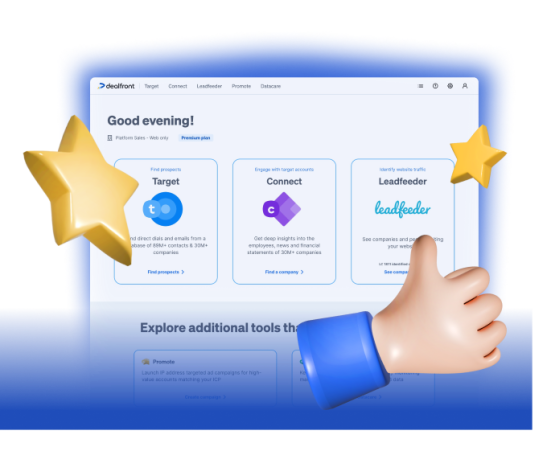Imagine you’ve logged into the Dealfront Platform to search for a company by using the Connect tool. Your search results are a rich overview of what the company does, displaying keywords and industry codes.
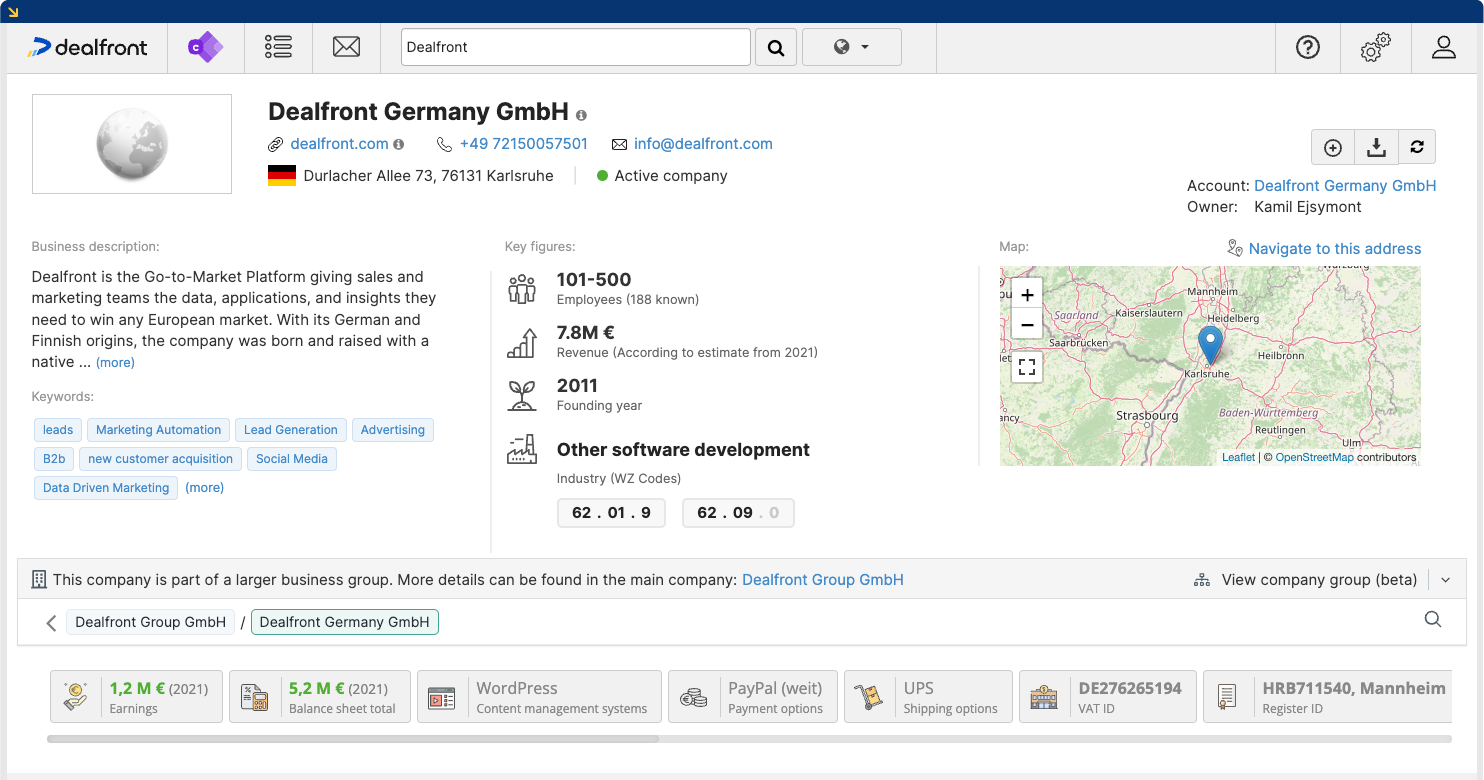
Example of the company overview page within Dealfront Connect
You also search for companies similar to your existing customers and you get a list of B2B lookalikes with the click of your mouse. You can extend that even further within the platform using Dealfront Target with filters based on keywords, industry, region or Trigger Events:

View of the filter overview in Target
This is what a Keyword and Topic Search looks like in Dealfront Target:

We think it’s pretty amazing, but what is the magic that makes it all happen? With our AI technology we called Company2Vec. Our very own unique neural network was developed in-house to specifically analyze all relevant public content.
That includes things like:
Websites
Trade register entries
Recently announced company changes (new headquarters, hiring)
How does Company2Vec work?
Company2Vec is a neural network that uses Natural Language Processing (NLP) to bring together linguistics, computer science, and AI. And you may have guessed, the language of computer science and AI is numbers. So for natural language to be processed by machines, we have to solve a very basic problem: how can we convert text into numbers so the machine can even process anything?
In the past, you would just assign a number to each word so you’d have text becoming a series of numbers. This allowed machines to learn patterns and recurring structures. However, for the computer, the number string for the word “boss” for example, was just a placeholder without context. The actual nuances of language like definitions, synonyms, plural/singular forms weren’t discernible by the computers.
The big breakthrough came when NLP researchers realized that they could express language through vectors with special properties. A vector in itself is actually not that exciting. In a three-dimensional space you plot x, y, and z coordinates on your graph. In NLP, the principle is the same but the vectors have many more than three dimensions.
Vectors in space: AI at Dealfront
Regardless of the dimensions, you now have points in space (vectors) that have the practical property that determine the distance between two points. With NLP, we can assign a point to each word so that similar words are as close to each other as possible. For example, the points (vectors) for the words “boss” and “bosses” could now be closer to other similar points. The first successful version of this was Word2Vec.
Similar vector models are the foundation of almost all deep learning applications that process text.
So where does our Company2Vec come in? In the NLP field, they faced the problem of how to make words accessible to learning algorithms without losing their properties and meaning. Just as Word2Vec uses vectors to express word similarities through distance via points, Company2Vec uses the same technology to express company similarities.
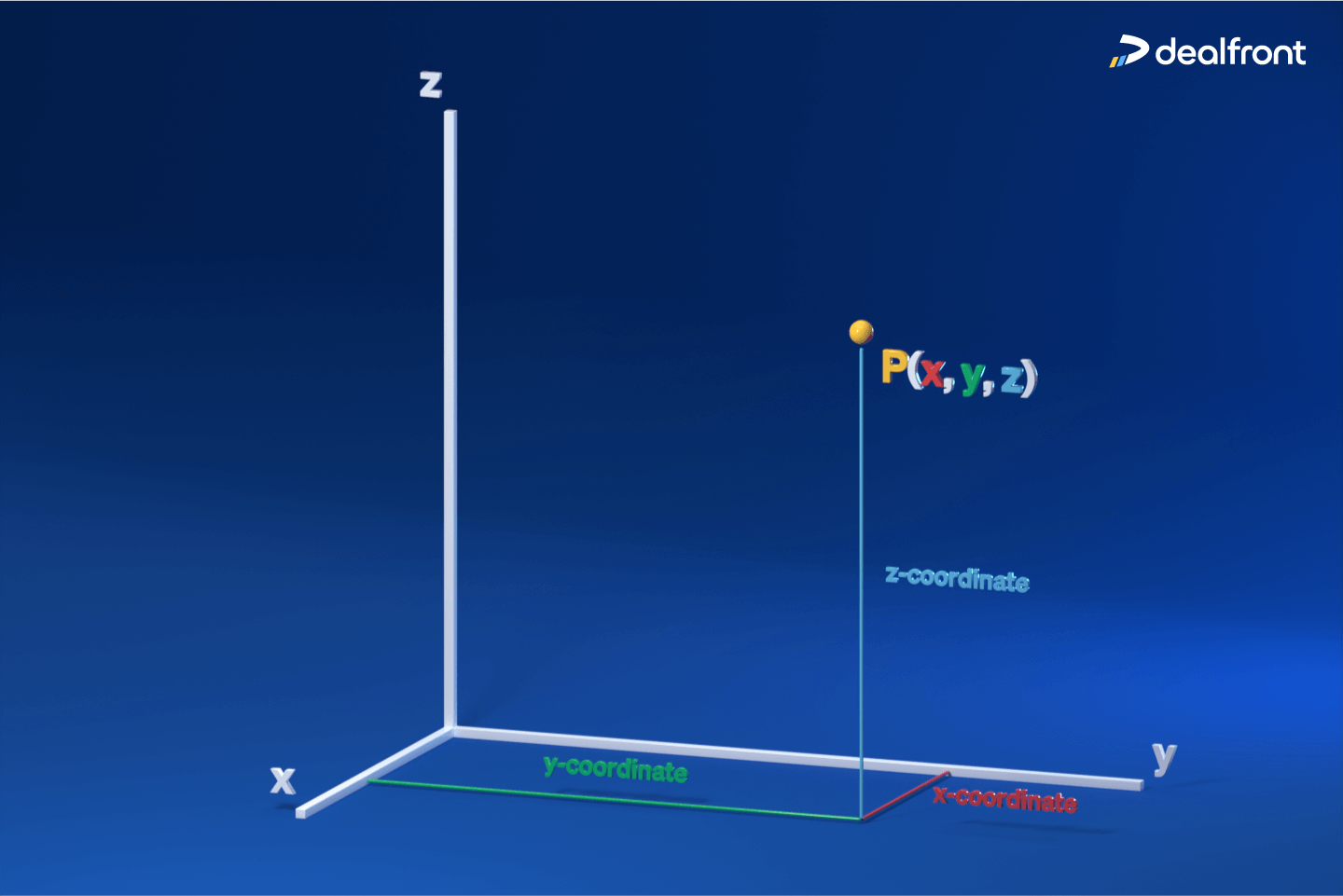
The deep Company2Vec neural network takes various texts (like company descriptions) from company web pages or from official company registers. This was a huge breakthrough for us because it created the basis of our software.
Practical applications of AI: Company2Vec vs. machine translation
You’re probably already familiar with tools like Deepl or Google translate which can translate whole phrases and not just words. Translation technology began with simple computing and evolved into using the same vector representation principle we have today. Translation tools can either provide us with very accurate translations or very strange combinations of words that make no sense.
In this case, vector encoders pack the entire meaning of sentences into vectors. Then, these are reverse engineered back into full sentences by vector decoders in the target language.
For machine translation, the context and actual phrase are both relevant. That means the encoder must be trained to recognize all the language nuances so it can produce an accurate translation. That’s all in the vectors!
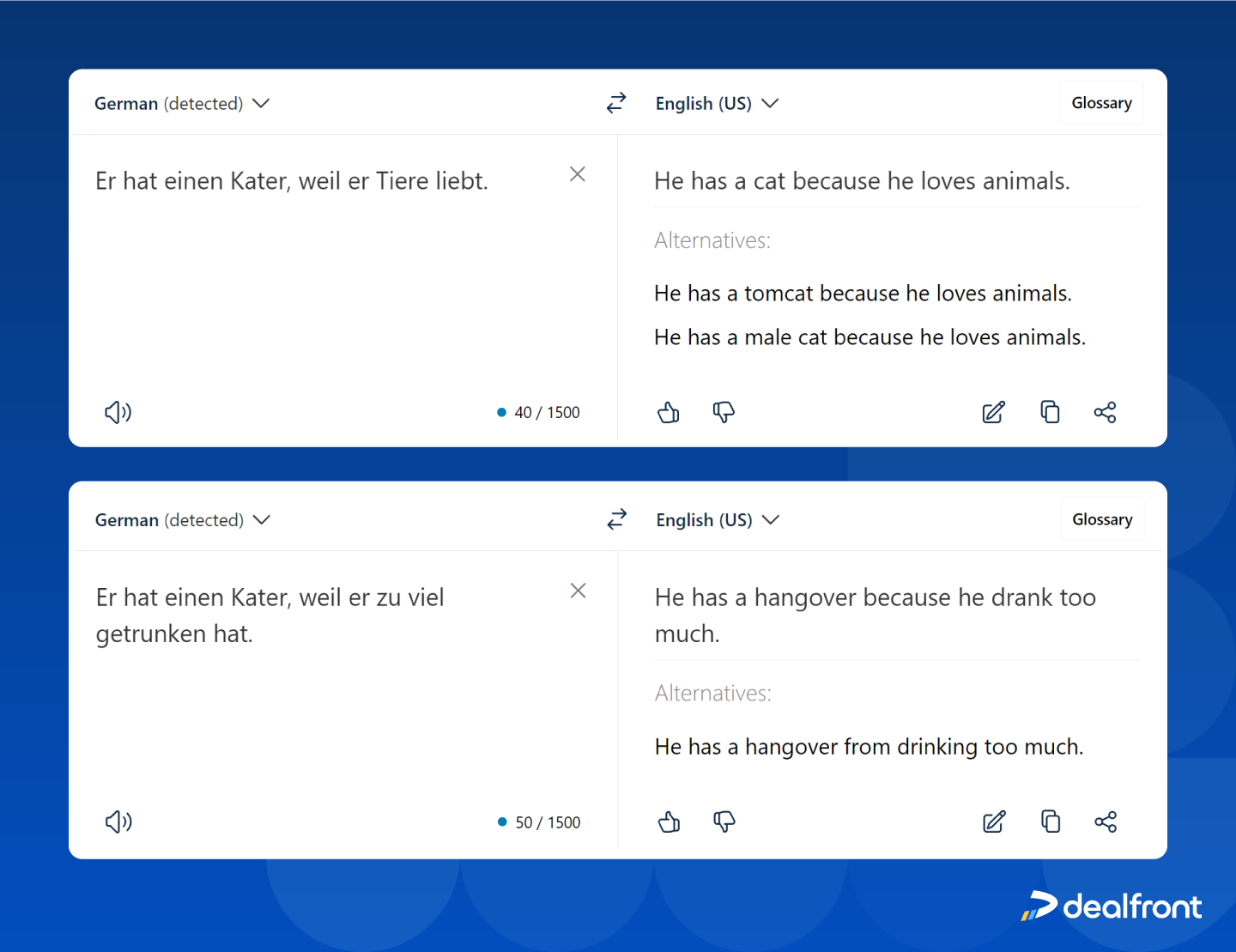
An example of a translation using DeepL.com
The AI recognizes the context of the same word, Kater, in different contexts resulting in different translations.
With our Company2Vec encoder, things are a little different. If we want to collect information on a company’s activity, target market and size, we have to train the encoder to extract only the company description or web page information that’s relevant to us.
That means, the encoder must be able to work without relying on the wording. In machine translation, the vectors differ depending on the context. With Company2Vec, they should be as similar as possible if the company is the same.
What makes Company2Vec so special?
Here at Dealfront, we’ve found a way to train the Company2Vec encoder to capture only relevant company data. That means, in the vector space where companies are mapped, we’re able to put companies that are similar close to each other.
Using our training procedure, these learned similarities are very intuitive and close to human evaluation. Another great feature is that we can also localize this procedure! The encoder can also display companies that have text in foreign languages, onto the same vector space.
With this input data, we’ll be able to develop better neural networks for a variety of company-related applications. Our base technology will benefit our customers for years to come, and we’ll be rolling that out gradually in additional languages.
Martin Meyries, Data Science Manager @ Dealfront
The practical applications in our platform
Company2Vec is used all throughout our product landscape. We’ve already talked about how it plays a major role in finding similar companies. It also can suggest industry codes and can display the standards of different countries in comparison to each other.
Keywords play a huge role in our platform and Company2Vec can check their relevance by seeing if the same keyword is used by similar companies. If so, it’s being flagged as a good or highly relevant keyword. And of course, we’re working hard on other fields of application! In the future, all models where company activity plays a role (company sales or who their next customer could be), will be based on Company2Vec.
So here’s how Company2Vec works in the real world:
→ A lab equipment manufacturer is looking for similar companies to their existing customer base to win as new customers.

A filter search of companies similar to your current customer base
→ Dealfront Target (or, Company2Vec) recognizes different clusters such as medical labs, swimming pools, chemical companies etc.
→ Target then displays 350 new and highly-interesting companies including relevant details and contacts to the lab equipment manufacturer.
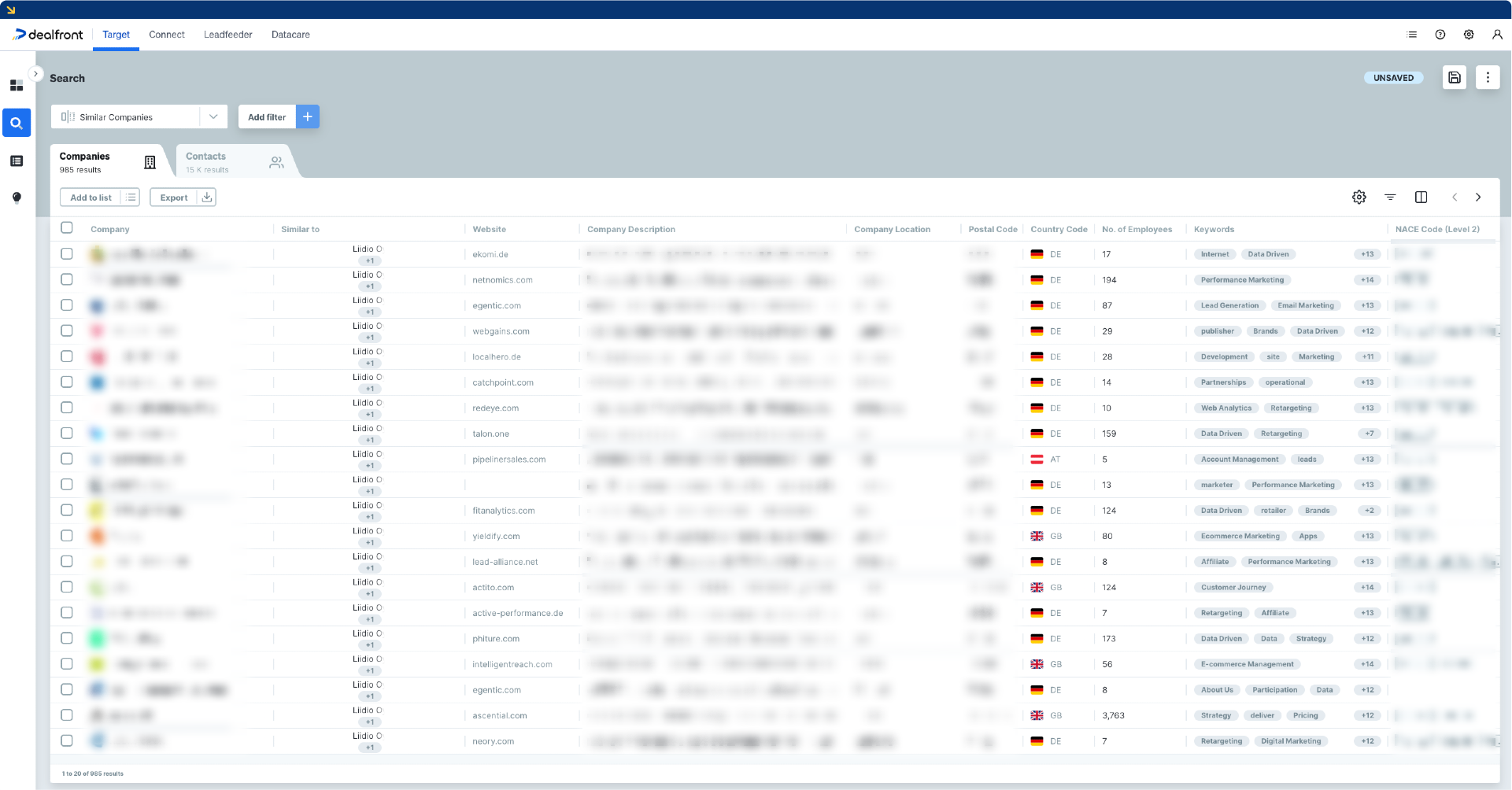
Results of the filter search showing all the companies similar to your current customers
Dive into untapped opportunities with Company2Vec
There’s a lot of “magic” that goes into creating something like Company2Vec, but the most important thing is how the benefits can help you achieve your business goals.
Save research time: Company2Vec cuts out manually scouring the web for companies that may or may not match your existing customer base. And who knows? You may find companies that you’d have never found otherwise.
Personalized pitches: Use what you’ve already learned from your current customers to create tailor-made pitches for your newly found companies.
High-quality leads: Your current customer list is filled with companies that fulfill your highest quality standards. You can feed that list into the system and the companies that it finds will result in companies of the same quality.
Now all that’s left is for you to see how it can work for you and your business! We offer a no-obligation demo so you can try out the AI for yourself.

